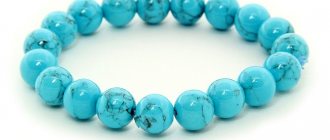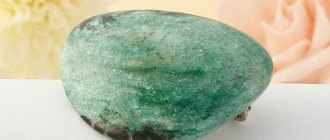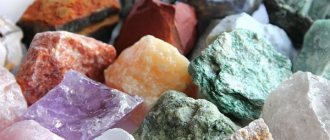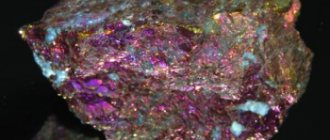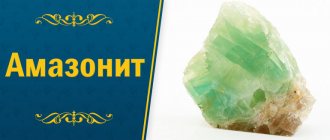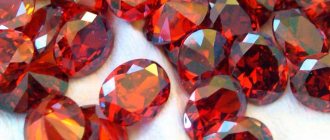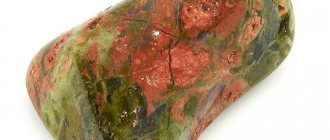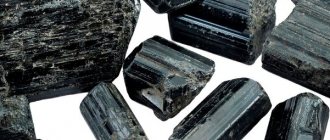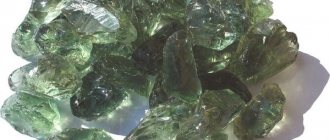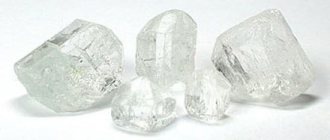Turquoise is a mineral that is a hydrous phosphate of copper and aluminum. This is a popular semi-precious jewelry stone. Translated from French, turquoise is a Turkish stone. Its extraction began in the Iranian province of Khorasan, and delivery to Europe took place through Turkey along the Great Silk Road. Therefore, Europeans associated the mineral with Turkey.
Basic physical and chemical properties:
Formula – CuAl6(OH)2[PO4] 4H2O
Color – bright blue, bluish-green, green, blue, sometimes yellow; may contain brown inclusions
Opaque
Hardness on the Mohs scale – 5-6
Gloss – matte, waxy
Line color (scratch) – white
Density – 2.6-2.8 g/cm³
Astrological and metaphysical properties:
Chakras – heart and throat
Third Eye Chakra Birthstone – December (Blue Turquoise)
Suitable for Zodiac signs – Scorpio, Sagittarius, Aquarius, Pisces
Planets – Venus and Neptune
Mystics believe that turquoise develops clairvoyance and allows you to see the future. This stone has powerful energy. If you wear turquoise jewelry constantly, the mineral helps develop the mind and strengthens memory. In the old days they believed that a blue stone set in consecrated silver provided protection from evil spirits, the evil eye and curses.
Pressed turquoise as a response to increased market demand
Turquoise has been a mineral beloved by all peoples since ancient times. For many centuries it has remained in demand and popular, and therefore, despite the fact that this rock is not considered rare, today natural high-quality stones are not often found on the market. Time passes, existing mines are depleted, and the development of new ones is carried out inactively - it is not always economically profitable, since it is typical for gemstones to occur in small quantities.
And, nevertheless, the needs of the market must be satisfied, and therefore jewelers resort to various tricks. One such trick is pressed turquoise. Let us immediately note that the answer to the question of whether it is natural will be positive, but this is a natural stone of the lowest quality existing on the market.
Methods of counterfeiting
Craftsmen have learned to make high-quality fakes of the expensive turquoise stone. Imitations are conventionally divided into 2 categories: with natural turquoise and with synthetic components in the composition.
Turquoise - the properties and meaning of the stone for a person who is suitable ✨Since ancient times, turquoise has been considered a stone that brings...
Published by Marina Brusinenko Jewelry Monday, July 9, 2018
Using natural turquoise
There are methods for creating stone imitations based on the use of natural raw materials.
| Material | How do you get it? |
| Pressed stone | The most common method of imitation. The composition of the mixture for pressing includes crumbs obtained during the process of grinding and polishing high-quality mineral. Often the formula of the mass includes admixtures of other minerals, the cost of which is lower than the price of genuine turquoise. The powder obtained from minerals is glued together with a special glue, and then pressed into briquettes. Then beads and inserts for jewelry are cut from the briquettes. The highest quality and most valuable pressed turquoise is considered to be reticulate or gossamer. It is characterized by the presence of a beautiful ornament. The stone restored from powder can be found in a variety of jewelry: silver and gold pendants, earrings, bracelets, brooches, rings. |
| Viennese | A pressed mixture that consists of malachite, as well as additional components in the form of phosphoric acid and aluminum hydroxide. All substances are thoroughly crushed, which allows them to be compressed. Vienna turquoise is destroyed under the influence of high temperatures - the stone melts and then cracks. The material is used in the production of costume jewelry, souvenirs, and decorative items. |
| Stabilized | The master fills the pores of the gem, which are formed as a result of natural processes, with special compounds. The substances used to fill defects consist of wax or resins. |
| Painted old minerals | Turquoise has an unstable chemical composition, so it changes appearance. During the aging process, the color acquires yellow-green inclusions, the area of which gradually increases. The cost of such gems is decreasing, but coloring old samples with special compounds makes it possible to restore the attractiveness of the color. |
Synthetic
Synthetic analogues of turquoise do not contain natural minerals. The fakes consist of:
- glass;
- ceramics;
- plastics;
- plastic.
Artificial gems are used in the production of inexpensive jewelry and souvenirs. But if the product information mentions the word “turquoise,” then this is a deception on the part of the seller. It is also considered fraud to sell artificial gems at the price of genuine gems.
What is it - pressed turquoise
- The best stones are called natural, they are characterized by good hardness and can be inserted into jewelry without any preliminary chemical manipulation. Natural minerals are subjected only to mechanical processing - cutting, polishing, etc.
- In second place in quality is fortified turquoise. In this case, the intervention of the jeweler, in addition to mechanical manipulations, consists of strengthening the hardness of the stone with various natural and artificial chemical cements - polystyrene, resins, paraffin, fat, evaporated quartz, etc. By the way, when processed with evaporated quartz, the stones are completely indistinguishable from natural ones, and even special gemological tests cannot reveal the differences.
- The third, still honored place, is occupied by ennobled turquoise. Here, processing with dyes is added to the treatment with cements. In this case, the source material is minerals with a dull color or unclear structure, and therefore they need to be artificially tinted to make them more attractive. Jewelry with ennobled gemstones is easy to distinguish from natural ones - the former are distinguished by deliberate ideality - too glossy, too polished and unnaturally bright.
- And finally, the pressed turquoise we are considering are stones of the lowest standard. How are they made? Using a press from powder or waste from processing minerals of higher quality. Many people call such products imitation, but this is not true. Yes, we are not talking about a whole stone here, but about particles of many stones, but, one way or another, these particles represent nothing more than real turquoise. So the question of how a pressed stone differs from a real one is not correct.
Protey's wood & Protey's travels
Sergey Denin (Protey) Photo by the author.
Paradoxically, all over the world, turquoise mines are steadily reducing production due to depletion, and the number of products with “turquoise” and the size of inserts in jewelry are constantly increasing. For example, since the late 60s of the 20th century, Uzbekistan has been the main supplier of turquoise for the USSR jewelry industry [1]. As of 2011, according to the author, turquoise is not mined at all in Uzbekistan.
Multicolor of natural turquoise.
Just a couple of decades ago, when buying turquoise jewelry, no one could even imagine that the product might not contain a natural stone, but an imitation. Today, at the beginning of the 21st century, the opposite picture is observed - most buyers have no doubt at all that any bright blue inserts in jewelry are real turquoise, and everything else is unknown, but certainly not: “We don’t know real turquoise !?”… This is hardly surprising. We admire tastes obtained through chemicals, consume foods modified at the genetic level, and dress in clothes made from oil. The world has become so synthetic and artificial that we reject muted and subtle naturalness as imperfection.
Thin crusts of turquoise in the form of veins in cracks in the host rock are not uncommon in turquoise-bearing occurrences. Chatkal-Kuraminsky turquoise region, Uzbekistan.
I was prompted to write an article about turquoise by numerous notes on different sites, polemics on forums, differences in terminology and translations, “educational” opuses from stone sellers, “explaining” what is considered real and what is not, where everyone is trying to whitewash and denigrate theirs. competitors. Unfortunately, most of the information in the virtual space brings us little closer to answering the question: what is before us, the beauty of nature or the human mind? I want to warn you that in this article, as well as in any other, you will not find a definite answer. Still, I hope that the information presented here will help you navigate this complex issue and help you avoid misconceptions and gross mistakes when choosing jewelry.
Veins of turquoise in quartz. Kyzylkum turquoise region, Uzbekistan.
So, turquoise, a charming stone more than other gems, is surrounded by an aura of mystical beliefs and endless charlatanism.
Properties
Turquoise is one of the most volatile minerals. We all know and use the word “turquoise” in relation to color, but we don’t think about how incompletely it characterizes the color of natural turquoise. Indeed, in addition to classic turquoise, there are white, blue, green, light green, yellow, brown turquoise, as well as various intermediate shades and color combinations. The color of turquoise can vary within one deposit and even within one piece of raw material.
Various shades of turquoise in one piece of raw material. Kyzylkum turquoise region, Uzbekistan.
In addition to uniformly colored turquoise, there are turquoise with color transitions, inclusions, and a network of other minerals - the so-called “turquoise matrix”.
On the left are turquoise buds with a brown-yellow network of limonite (limonite is a mineral, a mixture of iron hydroxides). On the right are beads made from similar raw materials. Chatkal-Kuraminsky turquoise region, Uzbekistan.
Sometimes the host rock gives turquoise its own tone - reddish, black, brown or darker shades of green and blue. Such variegated turquoise is highly valued, first of all, by collectors, but with skillful processing and appropriate design, reticulated turquoise, as well as stones with host rock, heterogeneous and variable-colored, are successfully used in jewelry.
Turquoise with a gray tint from the host shale rock. Kyzylkum turquoise region, Uzbekistan.
Turquoise, the brightest and most saturated “turquoise” color on the world jewelry stone market is considered ideal. The color of this turquoise is called “Royal Blue”. The vast majority of deposits in the world do not contain such turquoise at all, and only in some mines it is found in quantities of no more than 100 grams per ton (!) of lower grade. However, almost all mined turquoise is used, regardless of quality. Of course, no one uses a chalky substance of a vague pale color in jewelry. Such raw materials are either “improved” or used as a basis for the production of so-called reduced or pressed turquoise. In addition to color, turquoise differs in density and hardness. Usually these two characteristics are related. That is, the higher the hardness, the denser the stone and the higher its value. It is clear that harder stones will be less scratched and abraded during the use of jewelry. Another property is porosity. To one degree or another, it is inherent in any turquoise. Of course, monolithic aggregates are less porous and therefore are more valuable.
At the top is a fragment of turquoise of a greenish-light green color. Below is a thin fragment of blue turquoise. Kyzylkum turquoise region, Uzbekistan.
Due to its porous structure, turquoise is capable of absorbing fats, oils and liquids and changing color in the process, which apparently gave rise to legends about the changeability of the stone when it changes hands. From a physics point of view, there is no mysticism in this. Each owner of jewelry has his own habits and therefore, when one person, for example, is constantly in contact with liquids, the turquoise in his ring will be saturated with moisture and, accordingly, will be darker. If the ring has a “dryer” owner, then after some time the stone will evaporate the internal moisture and fade. Why not a script for a superstitious narrative? It is worth noting that the color saturation of natural turquoise in jewelry will change in any case, depending on the wearing style and habits of the owner. In the Middle Ages, turquoise was called the "butcher's stone" due to the fact that people in contact with animal fat had the most luscious turquoise jewelry. Apparently this observation subsequently contributed to the emergence of processes for improving the quality of stones by impregnation.
Original spotted turquoise. Kyzylkum turquoise region, Uzbekistan.
Since ancient times, turquoise mining has not been able to meet the high demand for the stone. And at all times, merchants resorted to all sorts of tricks to increase the quality and cost of goods. History has not preserved the names of the “inventors” who once came up with methods for improving the appearance of turquoise raw materials, but now many of these ancient methods have been further developed taking into account modern technologies. Nowadays, turquoise raw materials are impregnated with paraffin and wax, acrylic paints and epoxy resins, bombarded with electrons and boiled in autoclaves...
Heterogeneously colored turquoise in quartz rock. Kyzylkum turquoise region, Uzbekistan.
The processes for improving turquoise are numerous and are applied depending on the quality of the raw material. Typically, manufacturers are not inclined to share technological secrets with competitors and therefore in many cases limit themselves to just mentioning changes without going into details. The international market for jewelry stones has developed a terminology that denotes the effects that turquoise raw materials have been subjected to.
Terminology
Natural turquoise
Stone without changing the chemical composition and without any manipulation to change hardness, color, porosity. Those. a stone that has been found in nature and shaped according to the master's design. Apart from turning, grinding and polishing, the stone does not undergo any processing. Natural turquoise, due to its natural porosity, may change color to varying degrees over time due to the absorption of oils and fats upon contact with the human body and the environment.
A fragment of turquoise with areas of different color shades and inclusions of other minerals. Kyzylkum turquoise region, Uzbekistan.
Stabilized turquoise
Natural stone that has been chemically altered to reduce porosity. The purpose of the stabilization process is to prevent further discoloration of the stone due to unwanted absorption and subsequent leaching/evaporation of fats and liquids. As a result of stabilization, the color of the stone becomes richer. The effect is similar to increasing the brightness of the color of, for example, fabric when wet or darkening the surface of wood when moistened. Stabilization by impregnation with wax, fats or oils has been used since ancient times. And until now, paraffin impregnation is one of the most accessible methods of increasing the external characteristics of natural raw materials [1]. In industrial environments, impregnation with epoxy resin or polystyrene is more often used.
Ennobled or improved turquoise (“color-treated turquoise”), “color-enhanced turquoise”, “color-infused turquoise” - approximate translation: “color impregnation”, “color improvement”, “soaking in dye”)
Natural turquoise impregnated with a coloring chemical to improve color. In some cases, in addition to dye, substances that increase the hardness of the stone are added to the impregnation composition. Refined turquoise usually looks more juicy, often with a characteristic plastic sheen. The processes of improvement and stabilization are close. In both the first and second cases, the porosity of turquoise and the ability to absorb chemical compounds are used. Sometimes in American publications, impregnation with oil or paraffin (wax) is separated into a separate method of refining (waxing and oiling), and impregnation with dye is called dyeing.
Restored or pressed turquoise (reconstituted turquoise)
These are turquoise chips, substandard fragments and other turquoise waste, bound with epoxy resin or polystyrene and pressed into pieces suitable for processing. Often a dye is added to the binder polymer.
Synthetic turquoise
Nowadays, it is difficult to find a jewelry stone that has not been synthesized in the laboratory. In some cases, synthetic stones are practically indistinguishable from their natural counterparts either in chemical composition or physical properties. It happens that the cost of synthetic analogues is comparable to the cost of natural stones. This is due to the fact that many synthesis processes are very labor-intensive, and some are unprofitable for the production of jewelry raw materials. Let us at least recall the history of diamond synthesis. The Swedes were the first to obtain synthetic diamonds back in 1953, but gem-quality diamonds were synthesized in the USSR only in the late 1960s, and cost-effective synthetics were introduced to the diamond market only in the early 2000s by manufacturers from the United States.
Synthetic turquoise. Synthetics are often distinguished by the uniform and bright color of relatively large inserts in products. The price of products made from high-quality synthetic turquoise is much higher than all kinds of imitations, and sometimes can be higher than low-grade natural turquoise.
Attempts to synthesize turquoise also have a long history. Here's what you can read about this in the book by T.I. Menchinskaya “Turquoise” [1]:
“Synthetic turquoise was first obtained by M. Hoffmann in Germany in 1927. In terms of hardness, density and chemical composition, it practically corresponds to natural turquoise. In 1972, synthetic turquoise was produced in France. This synthetic material is uniform, has a beautiful turquoise-blue color and is the closest of all synthetic imitations to the best examples of Iranian turquoise. Cabochons made from this artificial turquoise are indistinguishable from natural ones even with precise research. […] In terms of basic physical properties, artificial turquoise is identical to natural varieties. Differences exist in the microstructure. […] Synthetic turquoise, practically indistinguishable from natural turquoise, was obtained in the late 70s. at the All-Union Scientific Research Institute for the Synthesis of Mineral Raw Materials E.E. Lisitsina. Both homogeneous varieties of bright blue color of various shades, and varieties with characteristic textural features close to reticulated or gossamer turquoise were synthesized. The chemical composition of this turquoise is similar to natural.”
Distinguishing synthetic turquoise from natural is not an easy task. Indeed, in addition to the same appearance, they are identical in chemical composition and physical properties. The only reassuring fact is that synthetics are actually turquoise. That is, a real mineral, and not a deception.
The methods of improvement and synthesis of turquoise listed above are based on manipulations with a natural mineral or raw materials synthesized in strict accordance with the natural formula and therefore, according to the author, the term “turquoise” is applicable to them. Below are described imitations that are not based on natural turquoise as such at all, and therefore the use of the name of this mineral in them is an outright deception and is intended to mislead gullible and uninformed buyers.
Imitation of turquoise with other minerals (imitation turquoise)
Some minerals are similar to turquoise in appearance and therefore can be passed off as turquoise in products. Of these, we can mention phostite, raschleichite, variscite, chrysocolla and others. The list of similar minerals is quite extensive and readers can search the Internet for possible imitations.
Chrysocolla is a mineral sometimes passed off as turquoise. It is less hard and usually has a richer color. Due to its great decorative value, it is sometimes used as cabochons in jewelry, but low hardness (2-4) compared to turquoise (5-7) and fragility limit its use.
Some minerals, like turquoise, are capable of absorbing chemical compounds. This allows you to create imitations by coloring. One of the most famous imitating minerals is howlite (synonyms: silicoborocalcite, caulite, turquenite). This is a white or grayish-white mineral, sometimes with brown or black veins similar to a turquoise matrix. It is easy to paint and therefore is widely used in the form of imitations of turquoise, other jewelry and ornamental stones, as well as corals. Howlite imitations are very similar to natural turquoise. Usually gives a richer color and a lower price.
On the left are beads made of natural Tien Shan turquoise, on the right are imitation colored howlite. The cut shows the shallow coloring of the fake. The jewelry was purchased at a market in Turkey.
There are imitations of complex composition, such as “Viennese turquoise” - a mixture of malachite with aluminum hydroxide and phosphoric acid; Neolithic or Riza turquoise - an imitation of turquoise with a host rock made of artificial bayerite - a by-product of aluminum production; neo-turquoise is an imitation of turquoise made from gibbsite and copper phosphate [1]. According to my observations, mineralogical imitations are becoming increasingly rare nowadays, due to the victorious march of artificial turquoise made from polymer and ceramic substitutes.
Simulated turquoise
A material similar to turquoise only in color. Typically, plastic, ceramics, glass, and enamel are used as replacements. Artificial turquoise is a product of chemical manipulation, which makes no sense to discuss within the scope of this article. It is worth recognizing that the vast majority of crafts with bright blue “turquoise” inserts - costume jewelry, beads, beads, brooches, souvenirs - on the price tags of which the term “turquoise” is proudly displayed, have nothing to do with turquoise or minerals in general.
Beads made of... a la turquoise. Price is approximately $13. Many people call this imitation and even consider it (!) turquoise. Typical consumer goods, found in abundance in the markets of the post-Soviet space. (Photo by Ilmira Denina)
Buying turquoise
Everyone makes the decision to purchase a particular product with turquoise or imitation for themselves. Some people prefer only natural stones; for others, color or size is more important, and it doesn’t matter what kind of processing the natural raw materials have undergone. Well, for some, the low price and catchiness of the product are primary and it does not matter at all what it is made of. Ignorance and bad taste of consumers encourage manufacturers to create outright mass consumer goods from chemical production waste and cheap raw materials of dubious origin. Alas, we ourselves create the supply with our low demand, and then we try to find pearls in the mountains of garbage... When buying, you need to understand that purchasing products made from natural turquoise or at least from improved turquoise raw materials is not an easy task. Typically, when selling jewelry, sellers refer to product label data, which cannot be completely trusted. Firstly, information about jewelry stones in the store is not checked, but simply copied from accompanying documents. At the same time, stones from mining to a jewelry store pass through many hands, and it is almost impossible to establish at what stage and by whom the gemological certification was carried out, the authenticity, grade, and value were determined. Secondly, there is no proper international control over the gemstone market, especially in the CIS and Southeast Asian countries, and sellers have a natural desire to change the characteristics in their favor. Thirdly, determining the quality and authenticity of stones requires experience, professional knowledge and special equipment. And even if the store employs a professional gemologist, its technical equipment may not be enough to establish the authenticity and quality of the stone. In addition, a full-time gemologist is more interested in the well-being of the employer rather than in establishing the truth. There are special independent certification centers in the world that carry out a comprehensive inspection of jewelry stones and issue a certificate. Gemological certificates are a guarantee of the authenticity and value of the stone. The author has no information about the existence of such centers in Uzbekistan.
Unfortunately, there is no clear method by which one could distinguish natural turquoise from fakes and improvements, but with some experience and care, obvious misunderstandings can be avoided when purchasing jewelry. Often a cursory examination of a mineral is enough to distinguish natural originality from a stereotyped imitation. In other cases, complex gemological examination is required to establish the truth. I will give some indirect signs that allow you to distinguish natural stone from imitations.
Price
Natural turquoise cannot be cheap. In the mineralogical and jewelry markets, the price of natural turquoise varies from tens of cents to several hundred dollars per carat (0.2 grams) and greatly depends on the quality of the raw materials. The richer the color, the more uniform the coloring and the more uniform the fragment, the more expensive the stone. The cost of stabilized and refined turquoise is lower than natural turquoise with similar external properties. When purchasing products, this can be used as an indirect sign.
Cabochon made of natural turquoise. Uneven coloring and inclusions inherent in natural stone are clearly visible.
As a rule, high-grade turquoise is used in expensive jewelry in combination with gold and diamonds. With silver, either lower quality natural turquoise is used, or stabilized, improved or restored. It would be naive to assume that beads made from solidly colored large blue stones with the word “turquoise” on the label for less than $100 contain natural turquoise. At best it is a mineralogical imitation, at worst it is ceramics or plastic. A few words about lower grade turquoise. Typically, such turquoise is traditionally used in national products of the American Indians, in Tibetan jewelry, and in crafts by craftsmen of the Middle East and Central Asia. It can be natural turquoise with uneven and “non-standard” coloring, mesh, interspersed with host rock, etc. Sometimes such turquoise looks very original, at the same time it has a relatively low price and, most importantly, it is born from nature.
Green turquoise. Along with the usual blue, it is widely used in jewelry. Kyzylkum turquoise region, Uzbekistan.
Greenish turquoise in the host rock. Such low-quality raw materials are not used in industry, but with skillful processing such a stone, whose color resembles snakeskin, can be successfully used in original jewelry. Kyzylkum turquoise region, Uzbekistan.
Size of stones
It is a great success to come across a large fragment of high-quality turquoise. Inserts made of high-grade natural turquoise cannot be large. Fragments the size of a walnut or larger are extremely rare. Large fragments are usually unevenly colored and are either sawed into smaller, uniformly colored pieces, or refined by any of the above methods. If an expensive product contains a uniformly colored stone of rich turquoise color the size of an almond, then most likely it is refined, synthetic or reduced turquoise. In turn, turquoise with uneven coloring, spotted, reticulated, interspersed with rock, etc. usually used in the form of large inserts, allowing one fragment to show all the shades of an unusual natural mineral.
Color
The more saturated the color, the greater the likelihood that it is, at best, refined or synthetic turquoise, and at worst, a plastic imitation. The most expensive first-class turquoise has a uniform, rich color. Paler ones are valued lower. Large and homogeneous stones of non-classical color can also have a high cost, especially collectible samples. According to the author, products made from natural turquoise of uneven color sometimes look more advantageous compared to plain turquoise stones, which raise doubts about their authenticity and are associated with cheap imitations or chemical improvements.
"Presumption of guilt"
To paraphrase the popular mining postulate - “if you doubt that this is gold in front of you, then it is definitely not gold” - you should not consider any turquoise, the naturalness of which you doubt, to be natural. If you are assured otherwise, offer to provide evidence or ask permission to conduct light tests on the stone. Test hardness by lightly scratching with a needle in an inconspicuous place. Due to its relatively high hardness (5-7), natural turquoise is difficult to scratch. At the same time, mineral imitations in the form of howlite (hardness 3.5) or chrysocolla (hardness 2-4) are easy to scratch. Immerse the stone in alcohol or vodka for a while and watch as naturally porous turquoise, as opposed to stabilized or enhanced turquoise, begins to darken or become stained as it absorbs the alcohol. (This is not dangerous for the product, as the stains will disappear after evaporation). Touch the back or hidden side of the stone with a needle heated in the flame of a lighter or match. Plastic and epoxy resin used in low-grade raw material improvement processes will melt. These simple tests will help distinguish natural turquoise from plastic imitations and stones enhanced with polymers. Unfortunately, identifying stabilized and synthetic turquoise or mineral imitations is much more difficult. Without special laboratory tests, this is not always possible even for a professional gemologist.
Conclusion
According to the author, even the most inconspicuous, but natural stones are much more valuable than refined and altered minerals. Natural stone is a part of nature - natural, unique, inimitable. It is impossible to find two identical stones, since nature is not capable of unification and replication, unlike man, who through his actions tries to improve the creation of nature to make it externally ideal and... depersonalizes the stone, bringing it closer in appearance to a piece of painted plastic.
Turquoise of rare color. Such stones are prized by collectors. For jewelry use, it will be difficult to cut out a fragment with a harmonious color. Kyzylkum turquoise region, Uzbekistan.
According to the International Gem Society, only 0.1% of the turquoise mined in the world is of the highest grade and less than 3% of turquoise jewelry contains natural turquoise. Therefore, you should not delude yourself about the jewelry stones in jewelry that have filled the markets of the post-Soviet space. Surely the statistics on the ratio of natural stones to all kinds of imitations and fakes are even sadder here. The range of products with “blue stones” is large and continues to expand, and we can conclude that what is important to buyers is not the naturalness and naturalness of natural beauty, but rather the brightness, size and price. Demand, as we know, gives rise to supply and the desire to satisfy this demand by any means, even dishonestly. That is why there is this unnatural blue in all kinds of decorations on the shelves of costume jewelry and tinsel stores, offered at bargain prices. In jewelry stores in Tashkent, I only came across products with natural or externally indistinguishable synthetic turquoise a few times. These were gold jewelry with a corresponding price. The vast majority of jewelry and products with turquoise inserts, sold both in reputable stores and souvenir shops, have nothing in common with natural stone. What should lovers of the refined natural beauty of natural stones and connoisseurs of artistic products of true masters and honest jewelers do? Alas, there is no clear answer to this question. We can only advise you to be careful. Do not buy jewelry and gems from dubious places, ask for a certificate, consult with specialists and experts...
1. Menchinskaya T.I., “Turquoise”, ed. 2. – M.: Nedra, 1989 2. https://en.wikipedia.org/wiki/Turquoise 3. https://www.mindat.org/min-4060.html 4. https://www .skystonetrading.com 5. State Committee for Geology of the Republic of Uzbekistan, State Enterprise “Geological Museum”.
Natural and pressed stone: differences
But there are still differences between natural and pressed stones.
- In the first case we are talking about a pure mineral, in the second one cannot count on absolute purity. Since the gem is made from waste, you need to understand that not only particles of turquoise, but also some of the “garbage”, which in this context means chalk-like rock and other minerals, end up in it and are pressed into place. In addition, glue, cements, and dyes are also added.
- On the other hand, if a product made of a pressed mineral indicates that it is exactly what it is, it is hardly worth treating it with skepticism. After all, this is an opportunity to buy beautiful jewelry made from a real semi-precious stone at an affordable price. In addition, this is a great option for lovers of massive jewelry. Of course, earrings made of pressed turquoise are perhaps an extra saving, because in this case, as a rule, small, modest stones are meant, but when it comes to massive bracelets and necklaces, pressed stones allow you to save considerable money.
However, the availability of jewelry is not the only advantage. Stones, artificially strengthened and painted, have higher hardness values than natural minerals without special treatment. And, in addition, they are brighter, do not fade over the years and do not require too much care.
What colors does turquoise come in?
The color largely depends on the deposit. Contrary to popular belief that natural turquoise has a bright blue hue, it is worth noting that this is not the only color that the mineral can be dyed. There are also gems in white, green, brown, yellow and even brown shades.
The most common color of the stone is, of course, blue or simply turquoise. In addition, the characteristic stripes on turquoise can also differ in saturation and color. Indeed, in addition to black stripes on the stone, one can also distinguish green, blue, brown and white layers.
Does pressed turquoise have magical properties?
With all this, the pressed mineral retains all the magical properties of the natural one. Perhaps they will be slightly weakened, but in general turquoise is such an energetically charged mineral that this weakening is unlikely to be noticeable.
- Jewelry or amulets made from it can dramatically change the life of its wearer. In many cultures, it was believed that this gem makes people truly powerful and protects them from illness and death. That is why, in ancient times, the mineral was worn with dignity by both fragile ladies and real warriors, whom it not only protected from wounds in battle, but also endowed with courage and bravery.
- And today he is ready to help the strong half of humanity, and not only representatives of the military profession, but also careerists. An amulet with a mineral helps to build good relationships with superiors and subordinates, to always be energetic and perspicacious. Making the right decisions is another important magical skill of the stone. By the way, for spiritually developed people, insight can even transform into foresight.
- Protects the gem and the family hearth. Place a turquoise figurine in your house and you will forget about quarrels and misunderstandings between household members. In addition, financial well-being will “settle” in the house.
- And according to Chinese culture, turquoise is a wonderful amulet for lovers. It protects against cheating, betrayal, lies, misunderstanding, and helps relationships develop harmoniously. However, all these advantages are attributed to green shades of turquoise in the Celestial Empire.
Characteristics of the stone
Turquoise stone is a mineral that has a sky blue, green-blue or gray-green hue. The color base of the stone may also have yellowish inclusions. From the point of view of chemical composition, it is aqueous copper phosphate with an admixture of aluminum. In nature, it occurs in the form of cryptocrystalline aggregates, veins, crusts and sinter formations. The formation of deposits is facilitated by geothermal processes occurring at temperatures up to 180 degrees.
The color of the mineral depends on the degree of maturity. Thus, a young gem has a pale blue tint. Mature turquoise has a rich color. If the stone is too old, it is characterized by brown tints. From the point of view of jewelry, an old mineral is considered of little value.
The hardness of real turquoise is 5-6 on the Mohs scale. The mineral is completely opaque. Has an oily sheen. Natural gems deteriorate when exposed to high temperatures.
Be sure to check out: How to Clean Gold and Silver Jewelry
Alternative names:
- arizonite;
- agaphyte;
- Turkiz;
- Arabic, Sinai, heavenly stone.
How does pressed mineral affect health?
Preserves pressed stones and healing magic.
- The mineral has a general healing effect on the body, strengthens the immune system, and fights chronic fatigue.
- The gem also has more “narrow” purposes - it treats insomnia and diseases of the nervous system, has a beneficial effect on the digestive system, heart, thyroid gland, throat and eyes.
- And he especially favors women's health - not only treats specific diseases, but also helps during childbirth. So if you believe in the magic of stones, be sure to take a turquoise amulet with you to such a significant event.
Types of non-original gems
It is difficult for the average person to find the differences between a real gem and a fake, since the latter have the same external characteristics.
Glass samples and cheap fakes
Glass and plastic are cheap materials that, after proper processing, look like turquoise stones. A glass or plastic fake has an unnaturally bright color and a regular pattern, uncharacteristic of natural specimens. The stone can be easily scratched by the point of a needle because it has a low hardness rating. Also, fakes quickly heat up from the heat of human hands.
Published by Mountain of Gems Monday, February 26, 2018
Similar minerals
Several mineral rocks are similar to turquoise and can be substituted for genuine samples.
Variscite
Hardness reaches 5 units. The color palette is richer than that of turquoise. In nature, in addition to blue flowers, there are yellow and green gems. Variscite can be recognized by the surface of the mineral: a characteristic top layer in the form of a crust; sometimes there are individual small crystals on the surface, like growths.
Lazulite
Blue spar does not contain copper, which introduces a blue tone and greenish tints. Lazulite contains aluminum phosphates. The base of the mineral is fine-grained; the distinguishing feature of turquoise is the secretive crystalline lattice of the rock.
Howlite, chalcedony and quartz
They try to counterfeit rocks that are not initially similar to turquoise. Such stones are colored artificially. Minerals are lower in cost, but brighter than the original. The original gem differs from howlite in density; it is softer and more pliable. Quartz is more transparent, chalcedony is heavier. Artificial fakes do not have pores, which are always present in natural rocks.
Ondolite
The natural blue gem was replaced with ondolite in ancient times. Ondolite is an organic formation. These are fossils of fossil animals: teeth, bones. Externally, it is almost impossible to determine which of the samples is the original. But a detailed examination reveals organic origin. Ondolite dissolves in hydrochloric acid.
Stages of checking for originality
A competent jewelry maker will help you avoid buying an imitation. He will also warn that after additional checks it will be revealed that the product is a scam, it can be returned and the money spent will be returned. Jewelers have developed tips that make it easy to verify the authenticity of a purchase.
- Check connection openings. They must match the color of the main tone of the stone. Any difference: whiter, darker is a sign of a fake.
- Learn about the method of processing the mineral. The pressed one goes through a special impregnation, the refined one goes through painting. Such gems are not fake; the seller is obliged to provide information about the method, because they require special care.
- View through a magnifying glass. Under a magnifying glass there will often be types of defects that are not typical for blue gems: color inclusions, cracks, bubbles.
- Wipe with a damp cloth. Check for stains; they appear on an unnatural sample.
- Rub with wool. A genuine product will attract the remains of napkins and lint to the surface.
- Check for density. Touch the decoration with a hot needle. Imitation will more often give off an unpleasant odor, similar to the smell of singed hair. The appearance of the original does not lose its attractiveness and does not frighten you with its pungent aroma.
- Mineral insert size. It should be remembered that there are no large specimens in nature.
- The shine of the product. The gem has a waxy glow; porcelain or glass makes one suspect deception.
For counterfeit jewelry, they do not issue certificates or specify where the gem was mined, so the easiest way is to request documents for the goods.
How to spot a fake
If you are thinking about buying products made from azure stone, be careful not to fall for the tricks of scammers and not waste money on a fake. There are tricks that will help you avoid mistakes when buying jewelry.
How to distinguish a real mineral from cheap copies:
- A crude fake can be easily distinguished from a real copy, since its surface is covered with low-quality dye. To perform the test, take a cloth and apply alcohol to it. Use a napkin to thoroughly wipe the pebble. If there are traces of paint on it, this means that this is a poorly made fake.
- Heat a regular sewing needle. Touch its tip to the surface of the stone. If an uncharacteristic chemical odor appears, this indicates that the copy is made of polymers. If the product contains sealing mixtures, then a sticky drop will appear at the puncture site.
- Examine the stone under a magnifying glass. Cracks and bubbles are signs of synthetic counterfeits.
- Turquoise tends to become electrified when rubbed against woolen fabric. After mechanical action, dust particles and hairs will adhere to the sample.
- Avoid buying jewelry with a large insert, since massive specimens of the stone are not found in nature. Also, large inserts are not made from compressed mass.
- A natural gem has a subtle waxy sheen, while a fake one attracts attention with a pronounced glossy sheen.
- Try scratching the sample with a needle or sharp knife. A thin scratch will remain on the original specimen, since the gem has an average hardness. If the stone cannot be damaged, this indicates that it is a copy made of quartz or chalcedony.
Important! At home, it will not be possible to distinguish pressed turquoise from the one that was mined in nature. To avoid spending money on a copy, pay attention to the reputation of the jewelry store where you purchase jewelry.
Ask the seller to present a document proving the authenticity of the gem. Beware of purchasing products with stones from unauthorized retail outlets. Only an expert gemologist can give an accurate assessment of the origin of a mineral.
Composition and properties
Callaite is a solution of copper and aluminum phosphate. The mineral consists of microcrystals and has a dense structure. Gems can be bluish and greenish tones. The sky blue color is due to the presence of copper in the composition.
If a gem is processed with a parent rock, then inclusions occur. There are varieties of turquoise:
- patterned;
- veined;
- arachnoid;
- interspersed.
The stone changes color in the sun, under the influence of chemicals, perfumes, fats, and sweat.
Deposits are concentrated in the countries:
- Iran.
- Chile.
- USA.
- Mexico.
- Tajikistan.
- Kazakhstan.
- Uzbekistan.
- China.
- Australia.
- Ethiopia.
Turquoise from Iran is prized. Deposits in Asia have been well studied, but geologists have differing opinions about the origin of the deposits. There is a theory that the nuggets are formed due to deep waters. Another point of view relates sediments to external waters.
All scientists combine precious fossils and weathering crust. The upper horizons are depleted quickly, which means kallaite will disappear.
Natural turquoise can be:
- strengthened;
- ennobled;
- reconstructed.
The stone is strengthened with cement, improving its decorative effect. This material is real. Strengthens medium quality callaite. For this, epoxy resin, quartz, polystyrene and other substances are used.
Turquoise is treated with dyes and polished. A refined product is valued less than one impregnated with cement. In the 20th century, the material was impregnated with wax and paraffin. Modern technologies use plastic, resins and sodium silicate.
Reconstructed turquoise is made from waste natural material.
A little history of fakes
Many people think that stones began to be counterfeited relatively recently, because the growth of technologies of this kind began to be observed starting from the end of the 18th century. However, this is not the case. Artificial turquoise, “obtained” from colored glass, has been known since the times of ancient Egyptian civilization.
It has long been known that it is easiest to slip a fake to a careless buyer instead of selling a natural stone mined with hard work. Cunning craftsmen could paint the product so that it was almost impossible to recognize the fake glass. The pebbles were no different from real ones. The fake looked simply great, except that it had an unnatural shine. The experienced eye of an inspector would immediately notice this fact. But since such trinkets were inexpensive and looked attractive, people did not think about how to distinguish turquoise from a fake, but were guided by a simple principle: beautiful means good.
In order to improve the quality of imitated products, the Egyptians learned to use simple chemical compounds. A certain technology for producing artificial products that have similar external properties to natural stone was known more than seven thousand years ago.
Of course, now it is possible to create much more of what is simply called “fake”. But if turquoise is imitated, stabilized or pressed with high quality, and sold inexpensively, why not wear such jewelry? On the other hand, it is always interesting to know what real turquoise looks like, so as not to overpay for something that costs much less. Moreover, the natural mineral is becoming less and less common on sale.
Main conclusions
- Turquoise is a natural stone consisting of hydrous copper phosphate with aluminum impurities in its composition. Aesthetically attractive specimens have a high cost.
- Due to the fact that high-quality gems are rare in nature, there are technologies for refining turquoise, as well as restoring it from stone chips.
- Stabilization, pressing, dyeing are popular methods of refining. This turquoise cannot be called synthetic, since it is of natural origin.
- Imitations of the mineral are made from cheaper stones, which include lapis lazuli, chalcedony, and quartz. The substitutes are coated with a special paint that imitates the natural color of turquoise.
- Counterfeits are made from materials such as glass, plastic, enamel and ceramics. Inserts made from artificial raw materials are used in the production of costume jewelry. They may also be sold at the price of genuine minerals, which is considered fraudulent.
- Some methods used at home will help identify low-quality fakes. However, only gemological examination will give a reliable result, especially if pressed turquoise is considered.
Glass samples and cheap fakes
Glass is considered the oldest method of replacing the original. Turquoise beads were found in the tomb of Tutankhamun. The date of creation of the beads is 1350 BC. Today the method has not lost popularity. To create a rich blue palette, you will need cobalt.
In addition to the well-known glass base, they learned to fake it from other, more modern materials:
- Silicate formation. Enamel is mixed with metal oxides and glass. The densities of the samples are much higher than those of genuine rocks.
- Plastic. The cheapest jewelry is made from plastic. Small cabochons are cast, and a turquoise pattern is placed on the top layer. The color of the plastic is brighter, the color palette spreads evenly. The glossy shine is attractive and gentle. It is not difficult to recognize plastic; more often it looks unnatural, and somewhat flashy and pretentious.

